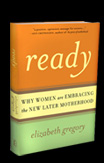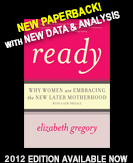About this book • Read an excerpt • read reviews • fast facts
Ready: why women are embracing the new later motherhood
Excerpt: Introduction
I never even thought about kids until my early thirties. But at that point, fresh out of grad school and starting the career I’d worked hard for, I could begin envisioning the future. Though there remained a few things I wanted to accomplish before taking the plunge, the attractions of children—of packing lunchboxes, telling jokes at the dinner table, and singing with my own kids the songs my mama sang to me—were exerting new influence.
A few years later, on a hospital visit to a good friend who had just delivered her second child, my husband and I admired the rather surprised-looking baby, listened to the heroic labor story, congratulated everyone involved, and got up to go. As we hugged good-bye, my friend looked at me and said, “Your turn!”
We knew she was right. Recently married and newly tenured, Patrick and I definitely felt ready to expand our family. A year later, our first daughter was born on a steamy August day in Houston. I was 39.
Fast forward to kindergarten: When we walked into the classroom with our daughter on her first day, she took off to connect with all the other 5-year-olds, and we met a collection of moms and dads. Unlike the kids, the parents varied in age—but I was particularly alert to the moms: some were 20-somethings, but most had passed 30 and six of us were over 40. At 44, I was not the oldest. As a group, our mix was pretty standard for urban schools these days, though in some urban neighborhoods you have to look hard to find a new mom under 30. As we worked on school projects together in the next few months, I learned what these women did for their livings; they were doctors, administrators, software managers, scientists, architects, bankers, and dentists. Most of them worked full time, but several had “retired” from long careers—for the time being, anyway.
What a different scene from the one my mother entered when she first took me to kindergarten. Though she started her family at 30, most of the other moms were in their twenties. And while most of them had worked and some kept on working, their career paths tended to be much less professionally oriented, much less well paid, and often much shorter than moms’ careers today.
If you’re a woman thinking about children these days—either because you have them already or because you’re thinking about whether or when to have them—the link between job opportunities and age means something to you. Usually when you hear it mentioned in the media, it’s presented as a problem—even a contradiction. You may remember how a few years back Sylvia Ann Hewlett’s Creating a Life made a lot of us suddenly nervous about our fertility when she told us very firmly that, if women delayed their childbearing to focus on their careers, they were going to miss their opportunity to have kids. If you wait, you’ll be too late, story after story since then warns us.
But what about all the 40-something moms dropping off kids at the grade school gates these days? How do they fit into the picture?
With that question in mind, I decided to explore. Aside from a few “how to get pregnant over 35” guides and some support-group books for later moms, I found very little analysis of the trend and what it means for women, their families, and the wider community—though the day-to-day evidence suggests a revolution has occurred. Wouldn’t such a big change have big effects?
I started by checking the statistics. It turns out that between 1970 and 2004 the average age at which U.S. women gave birth for the first time rose from 21.4 to 25.2—an enormous change. For college-educated women (as of 2003) the average age at first birth was 30.1. Pulling up this average are big rises in the upper age ranges. In 2005, one in every twelve first births was to a woman 35 or over. That’s a lot more later families than in 1970, when one in every one hundred first children had a later mom. Add in the adoptive moms who start their families later, and you’ve got a substantial proportion of the population.
In fact, a vast number of women have had their first children after the age of 35 these days. In some places, it almost seems that most women begin having children after that age. The check-out line magazines are full of stories of celebrity moms on this timetable: Salma Hayek, Julia Roberts, Tina Fey, Geena Davis, Michelle Obama, Holly Hunter, Julianne Moore, Annie Leibovitz, and Susan Sarandon, to name just a few. Though lately we’ve had a spate of stories about fairly young celebrity moms, too, the impression that more and more women are starting their families later is confirmed by the statistics: over the past thirty years, the number of U.S. women who had their first child between the ages of 35 and 39 has multiplied by ten, increasing every year despite the predictions that women who wait will wind up living lonely, childless lives. And there are now thirteen times as many women giving birth to their first children in the 40 to 44 age range. Or, taking into consideration that the population has increased since 1975, we can gauge the trend more accurately by noting that the first birth rate per thousand women starting their families at 35 or after has quintupled in the past thirty years.
If you’re in this group, this statistic may not surprise you, but it does seem to be news to the media. If you tell your grandmother that women over 35 are having kids, it probably won’t surprise her either. After all, women over 35 have been having kids forever—it just hasn’t usually been their first child. My grandmother had her eighth child when she was 39, the same age at which I had my first. Hers was the old-fashioned kind of later motherhood. It’s the late onset of motherhood that’s new about later motherhood today.
After the first child, many new later moms go on to have more kids. Add all their kids together with the later kids of moms who started before 35 and then had more kids on the other side of that age line, and you’ve got an overall one in seven kids in the United States born to a mom 35 or more in 2005. That’s almost 600,000 children.
When I saw the statistics, I wanted to know more. I knew how good I felt about my own choice to have children later, but how did others feel about it? Did most later moms see the choice as a good one or a bad one in their lives? Did they feel they had waited too long, or was waiting the right thing for them? How did their choice affect their families, their jobs, and their relationships?
Pursuing these questions, I conducted a study of 113 “new later mothers”—women who had their first children by birth or adoption at or after 35. These are moms by both ordinary and extraordinary means: married moms, single moms, straight moms, gay moms, new moms at 35, and new moms at 56 and every age in between. They are biological and adoptive moms, mothers of one child, and mothers of several children. They are full-time working mothers, part-timers, and mothers who stay home full time. These are moms of many races and many professions—engineers, dancers, CEOs, doctors, teachers, lawyers, reporters, accountants, and on and on.
The results were fascinating. I went into this study expecting mixed responses and that the women would have conflicting feelings about their choice. But, while there was some complexity, the overwhelming majority of women viewed the choice to have children after 35 as one of the most positive choices they had made in their entire lives. That’s the real story.
These new later mothers live in a very different world from the one the media portray. The women I’ve met enjoy motherhood immensely, and most combine it with satisfying work. Others have “retired” into motherhood, while still others have stepped out of the workforce but plan to step back in down the line. These women live in a world where most women succeed in starting their families later—usually in the standard way, sometimes by adoption (the route by which our second daughter joined our family), and sometimes with the help of fertility technology, but consistently with profound happiness. These women feel they’ve come to motherhood prepared and that their children, their marriages, their careers, and their sanity are by far the better for it.
These moms are ready. The word popped up time and again in my interviews. The precise definition of readiness differed with each woman, but commonalities emerged fast. Most consistently, I heard that waiting offered the women I spoke with the chance to establish themselves, as individuals and in their work, to find the right partner for the long term—or to determine that single parenthood made the most sense for them—and to achieve a measure of financial stability. They felt they’d sown their wild oats, tested their mettle, and established their senses of self, so that now they were ready to focus on their children’s development rather than on their own. Lena, a journalist now in her mid-fifties and the mother of two teenagers, remarks that children care most of all about your being there for them—both literally and figuratively. She notes, “I could have never shown up [for them] in my twenties because I was busy trying to show up for myself.”
Used with permission from Basic Books © 2007.
About this book • Read an excerpt • read reviews • fast facts



